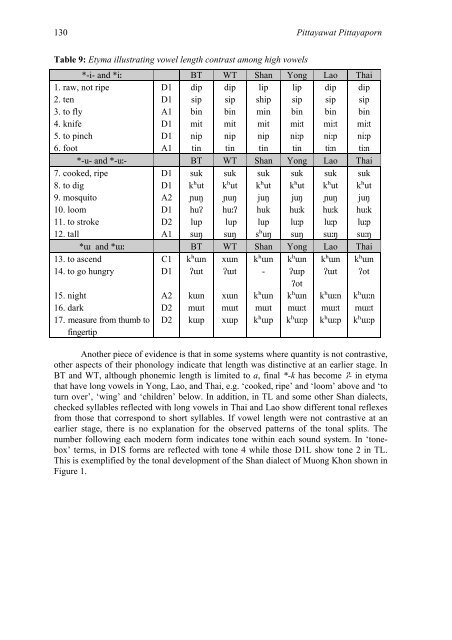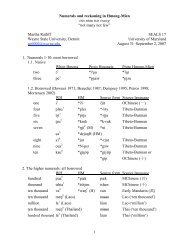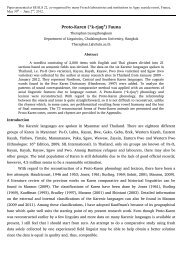proto-southwestern-tai revised: a new reconstruction - seals 22
proto-southwestern-tai revised: a new reconstruction - seals 22
proto-southwestern-tai revised: a new reconstruction - seals 22
You also want an ePaper? Increase the reach of your titles
YUMPU automatically turns print PDFs into web optimized ePapers that Google loves.
130 Pittayawat Pittayaporn<br />
Table 9: Etyma illustrating vowel length contrast among high vowels<br />
1. raw, not ripe<br />
2. ten<br />
3. to fly<br />
4. knife<br />
5. to pinch<br />
6. foot<br />
*-i- and *iː BT WT Shan Yong Lao Thai<br />
D1<br />
D1<br />
A1<br />
D1<br />
D1<br />
A1<br />
dip<br />
sip<br />
bin<br />
mit<br />
nip<br />
tin<br />
dip<br />
sip<br />
bin<br />
mit<br />
nip<br />
tin<br />
lip<br />
ship<br />
min<br />
mit<br />
nip<br />
tin<br />
lip<br />
sip<br />
bin<br />
miːt<br />
niːp<br />
tin<br />
dip<br />
sip<br />
bin<br />
miːt<br />
niːp<br />
tiːn<br />
dip<br />
sip<br />
bin<br />
miːt<br />
niːp<br />
tiːn<br />
*-u- and *-uː- BT WT Shan Yong Lao Thai<br />
7. cooked, ripe<br />
8. to dig<br />
9. mosquito<br />
10. loom<br />
11. to stroke<br />
12. tall<br />
D1<br />
D1<br />
A2<br />
D1<br />
D2<br />
A1<br />
suk<br />
kʰut<br />
ɲuŋ<br />
huʔ<br />
lup<br />
suŋ<br />
suk<br />
kʰut<br />
ɲuŋ<br />
huːʔ<br />
lup<br />
suŋ<br />
suk<br />
kʰut<br />
juŋ<br />
huk<br />
lup<br />
sʰuŋ<br />
suk<br />
kʰut<br />
juŋ<br />
huːk<br />
luːp<br />
suŋ<br />
suk<br />
kʰut<br />
ɲuŋ<br />
huːk<br />
luːp<br />
suːŋ<br />
suk<br />
kʰut<br />
juŋ<br />
huːk<br />
luːp<br />
suːŋ<br />
*ɯ and *ɯː BT WT Shan Yong Lao Thai<br />
13. to ascend<br />
14. to go hungry<br />
15. night<br />
16. dark<br />
17. measure from thumb to<br />
fingertip<br />
C1<br />
D1<br />
A2<br />
D2<br />
D2<br />
kʰɯn<br />
ʔɯt<br />
kɯn<br />
mɯt<br />
kɯp<br />
xɯn<br />
ʔɯt<br />
xɯn<br />
mɯt<br />
xɯp<br />
kʰɯn<br />
-<br />
kʰɯn<br />
mɯt<br />
kʰɯp<br />
kʰɯn<br />
ʔɯp<br />
ʔot<br />
kʰɯn<br />
mɯːt<br />
kʰɯːp<br />
kʰɯn<br />
ʔɯt<br />
kʰɯːn<br />
mɯːt<br />
kʰɯːp<br />
kʰɯn<br />
ʔot<br />
kʰɯːn<br />
mɯːt<br />
kʰɯːp<br />
Another piece of evidence is that in some systems where quantity is not contrastive,<br />
other aspects of their phonology indicate that length was distinctive at an earlier stage. In<br />
BT and WT, although phonemic length is limited to a, final *-k has become ʔ- in etyma<br />
that have long vowels in Yong, Lao, and Thai, e.g. ‘cooked, ripe’ and ‘loom’ above and ‘to<br />
turn over’, ‘wing’ and ‘children’ below. In addition, in TL and some other Shan dialects,<br />
checked syllables reflected with long vowels in Thai and Lao show different tonal reflexes<br />
from those that correspond to short syllables. If vowel length were not contrastive at an<br />
earlier stage, there is no explanation for the observed patterns of the tonal splits. The<br />
number following each modern form indicates tone within each sound system. In ‘tonebox’<br />
terms, in D1S forms are reflected with tone 4 while those D1L show tone 2 in TL.<br />
This is exemplified by the tonal development of the Shan dialect of Muong Khon shown in<br />
Figure 1.





